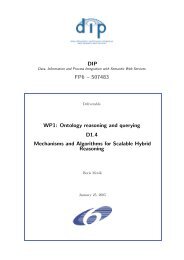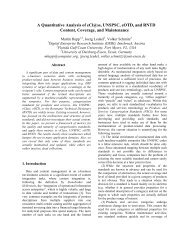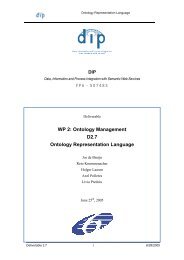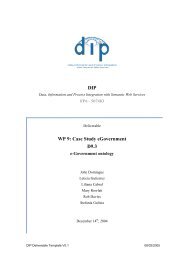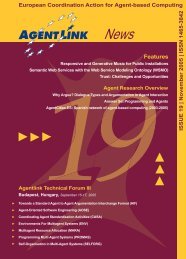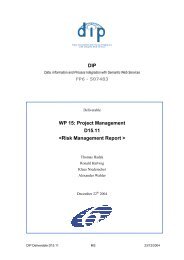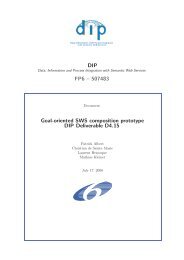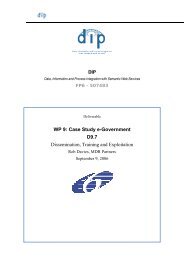WSMO descriptions of application 1 - DIP - Semantic Web
WSMO descriptions of application 1 - DIP - Semantic Web
WSMO descriptions of application 1 - DIP - Semantic Web
Create successful ePaper yourself
Turn your PDF publications into a flip-book with our unique Google optimized e-Paper software.
<strong>WSMO</strong> <strong>descriptions</strong> <strong>of</strong> <strong>application</strong>.1. INTRODUCTIONThis document introduces the <strong>WSMO</strong> formal description <strong>of</strong> eBanking Case Study <strong>Web</strong>Services. The objective <strong>of</strong> this document is tw<strong>of</strong>old: on the one hand it provides a usefulrequirement set for <strong>DIP</strong> s<strong>of</strong>tware infrastructure and on the other hand it contributes tothe construction <strong>of</strong> basic eBanking SWS infrastructure.The eBanking case study covers almost all typical scenarios <strong>of</strong> <strong>application</strong> constructionand integration using SWS technology. The <strong>application</strong> automates the process <strong>of</strong>collecting mortgage data from several banks, taking into account that the data can beaccessed by executing SWS from different banks. Then it provides this aggregatedinformation to users, according to the data that they have filled-in in appropriate queryforms.From the business point <strong>of</strong> view it helps the bank customer to find out the best mortgageproduct. Even if the functionality is not new (many banks already include it in theirservice <strong>of</strong>fering) the underlying technology is revolutionary. The usage <strong>of</strong> <strong>DIP</strong>technology allows for low cost and quick <strong>application</strong> construction and adaptation to themarket evolution and needs. In a short period <strong>of</strong> time and with less effort thantraditional s<strong>of</strong>tware development, the bank is able to deploy new business processes totheir customers.This document is organized as follows: section 2 defines the general organization <strong>of</strong> theUse Case; Section 3 presents examples <strong>of</strong> specific <strong>WSMO</strong> <strong>descriptions</strong>. Section 4concludes the document.2. USE CASE OVERVIEWThis section provides a description <strong>of</strong> the setting <strong>of</strong> this use case.2.1. INTRODUCTIONComparador.com is a web portal that provides mortgage information <strong>of</strong>fered byfinancial organizations to its users. At this moment this process is not automatic andrequires human interaction; since a worker has to update the information baseswhenever there is a change in the mortgages, the maintainance cost is elevated. UsingSWS this process can be automated, reducing the costs and increasing the quality <strong>of</strong> theinformation since the data are collected in real time.Actually these kinds <strong>of</strong> services are fed with data obtained with screen-scrapingtechniques or filled in by humans. These data are used internally to resolve the requiredmathematic formulae. Thus, the information should not be quite accurate, since slightlydifferent formulae could be used by each Bank, as is actually the case.In contrast with these kinds <strong>of</strong> services, in our Case Study data is to be calculated byeach Bank provider, using its own formulae and, therefore, certifying the results in realtime. It is then possible to apply this case study to other industrial sectors. For example,it can be used to create Simulator/Comparator <strong>application</strong>s to the Travel, Real State orInsurance sectors.- 1 -



